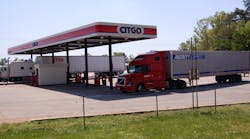Retail pump prices for diesel prices declined slightly this week across the nation, according to data tracked by the Energy Information Administration (EIA), while gasoline reversed course in six of nine U.S. regions monitored by the agency – resulting in an average 1.8 cent per gallon climb in retail gasoline prices at the pump.
The EIA said the U.S. average retail pump price for diesel dropped 6/10ths of a penny to $3.845 per gallon this week, which is 21.1 cents per gallon cheaper compared to the same week in 2012.
The agency added that diesel prices increased in only the Midwest, climbing 2.9 cents to $3.868 per gallon, while dropping in every other region of the country. California – despite a 4.6 cent per gallon price drop – still remains home to the most expensive retail pump price for diesel this week at $4.001 per gallon, EIA said, while the Gulf Coast sports the cheapest diesel at $3.735 per gallon.
Gasoline, however, has reversed its pricing course, EIA noted – with the U.S. average retail pump price for gasoline increasing 1.8 cents to $3.538 per gallon, though that is still 25.2 cents per gallon cheaper compared to the same week in 2012.
The biggest jump in gasoline prices occurred in the Midwest; a 5.4 cent increase that pushed gasoline prices in that region to $3.608 per gallon. The Lower Atlantic is home to the cheapest gasoline in the U.S. this week, EIA added, with prices falling 7/10ths of a penny to $3.403 per gallon. The West Coast – which witnessed a 1.1 cent per gallon price increase this week – is home to the most expensive gasoline in the nation at $3.811 per gallon.
Widely different state fuel taxes are one reason for the growing disparity of gasoline prices across the U.S., EIA noted. While the agency said the average state gasoline tax throughout the nation is 23.5 cents per gallon (cpg), the range is very broad, with Alaska and Georgia, for example, charging just 8 cpg, while California charges 38.2 cpg – all in addition to the federal gasoline tax of 18.4 cpg.
EIA is now publishing a new table on the variety of tax mechanisms used at the state level in part as excise tax rates and fees are also varying widely from state to state. Declining revenue from these taxes — stemming in part from increasing vehicle fuel economy, fixed per-gallon rates that have remained unchanged for prolonged periods of time, and slow growth in miles-traveled — are reducing transportation funds.
That’s forcing several states and localities to create variable rates for a portion of the overall tax and even allowing some per-gallon taxes at the local level. An example of this process can be seen in Vermont, EIA noted, where a variable rate fee based on the statewide average retail price is applied to gasoline – along with a flat-rate fee on diesel – in addition to the flat rate excise tax.
In California, by contrast – the state with the highest level of motor fuel consumption – the gasoline sales tax is initially levied at the wholesale level at a prepaid rate currently set at 7 cpg for gasoline and 29 cpg for diesel fuel. When the product reaches the retail outlet level, the actual state- and district-level percentage rates are applied to the sale price of fuel sold to the consumer, EIA noted.
Maryland recently enacted variable fuel tax rates so that, beginning in July, a portion of its fuel taxes will be based upon the U.S. Consumer Price Index. A second component of Maryland's new fuel tax structure will be based on the average annual retail price of motor fuels multiplied by a percentage sales tax rate, whose rate is set to increase over the next several years, the agency pointed out.
In contrast, Virginia recently passed legislation that would completely eliminate current motor fuels excise tax – currently set at 17.5 cpg – and replace the revenue generated from it with a 3.5% wholesale tax on gas and 6% tax on diesel fuel; both of which starting in July as well. The EIA said that this fuel taxation method should help flat-tax shortfalls due to inflation, though periods of fuel price volatility could create some degree of uncertainty for this revenue stream.



